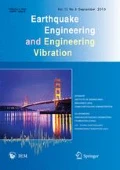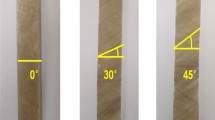Abstract
To investigate the seismic performance of hollow reinforced concrete (RC) bridge columns of rectangular cross section under constant axial load and cyclically biaxial bending, five specimens were tested. A parametric study is carried out for different axial load ratios, longitudinal reinforcement ratios and lateral reinforcement ratios. The experimental results showed that all tested specimens failed in the flexural failure mode and their ultimate performance was dominated by flexural capacity, which is represented by the rupture/buckling of tensile longitudinal rebars at the bottom of the bridge columns. Biaxial force and displacement hysteresis loops showed significant stiffness and strength degradations, and the pinching effect and coupling interaction effect of both directions severely decrease the structural seismic resistance. However, the measured ductility coefficient varying from 3.5 to 5.7 and the equivalent viscous damping ratio varying from 0.19 and 0.26 can meet the requirements of the seismic design. The hollow RC rectangular bridge columns with configurations of lateral reinforcement in this study have excellent performance under bidirectional earthquake excitations, and may be considered as a substitute for current hollow RC rectangular section configurations described in the Guideline for Seismic Design of Highway Bridges (JTG/T B02-01-2008). The length of the plastic hinge region was found to approach one sixth of the hollow RC rectangular bridge column height for all specimen columns, and it was much less than those specified in the current JTG/T. Thus, the length of the plastic hinge region is more concentrated for RC rectangular hollow bridge columns.
Similar content being viewed by others
References
AASHTO (2007), LRFD Bridge Design Specifications, Washington (DC): American Association of State Highway and Transportation Officials.
Bonet JL, Miguel PF, Fernandez MA and Romero ML (2004), “Analytical Approach to Failure Surfaces in Reinforced Concrete Sections Subjected to Axial Loads and Biaxial Bending,” Journal of Structural Engineering, 130(12): 2006–2015.
Bousias, SN, Verzeletti G, Fardis MN, and Gutierrez E (1995), “Load-path Effects in Column Biaxial Bending with Axial Force,” Journal of Engineering Mechanics, 121(5): 96–605.
CALTRANS (2006), Bridge Design Specifications, Sacramento: California Department of Transportation.
Calvi GM, Pavese A, Rasulo A, et al (2005), “Experimental and Numerical Studies on the Seismic Response of R.C. Hollow Bridge Piers,” Bulletin of Earthquake Engineering, 3: 267–297.
Chang SY (2010), “Experimental Studies of Reinforced Concrete Bridge Columns under axial Load plus Biaxial Bending,” Journal of Structural Engineering, 136(1): 12–25.
Chao SH and Loh CH (2009), “A Biaxial Hysteretic Model for a Structural System Incorporating Strength Deterioration and Pinching Phenomena,” International Journal of Non-Linear Mechanics, 44: 745–756.
Dhakal RP, Mander JB and Mashiko N (2007), “Bidirectional Pseudo-dynamic Tests of Bridge Piers Designed to Different Standards,” Journal of Bridge Engineering, 12(3): 284–295.
Dundar C (1990), “Concrete Box Sections under Biaxial Bending and Axial Load,” Journal of Structural Engineering, 116(3): 860–865.
GB (2010), Code for Design of Concrete Structures GB 50010-2010, Beijing: China Architecture and Building Press. (in Chinese)
Han Qiang, Du Xiuli, Liu Jinbo, et al (2009), “The Seismic Damage of Highway Bridges during 2008 Wenchuan Earthquake,” Earthquake Engineering and Engineering Vibration, 8(2): 263–273.
JTG/T (2008), Guideline for Seismic Design of Highway Bridges JTG/T B02-01-2008, Beijing: China Communications Press. (in Chinese)
Marante ME and Florez LJ (2002), “Model of Damage for RC Elements Subjected to Biaxial Bending,” Engineering Structures, 24(9): 1141–1152.
Pinto AV, Molina J and Tsionis G (2003), “Cyclic Tests on Large-scale Models of Existing Bridge Piers with Rectangular Hollow Cross section,” Earthquake Engineering & Structural Dynamics, 32: 1995–2012.
Priestley MJN, Seible F and Calvi GM (1996), Seismic design and retrofit of bridges, John Wiley & Sons, Inc., New York.
Qiu FW, Li WF, Pan P, et al. (2002), “Experimental Tests on Reinforced Concrete Columns under Biaxial Quasi-static Loading,” Engineering Structures, 24(4): 419–428.
Takizawa H and Aoyama H (1976), “Biaxial Effects in Modeling Earthquake Response of R/C Structures,” Earthquake Engineering and Structural Dynamics, 4: 523–552.
Taylor, AW, El-Bahy, A, Stone WC and Kunnath S (1996), “Effect of Load Path on Seismic Damage to RC Bridge Columns,” Proc. the 11th World Conference on Earthquake Engineering, Paper No.1897.
Wang GG and Hsu CT (1992), “Complete Biaxial Loaddeformation Behavior of RC Columns,” Journal of Structural Engineering, 118(9): 2590–2609.
Wong, YL, Paulay T, and Priestley MJN (1993), “Response of Circular Reinforced Concrete Columns to Multi-directional Seismic Attack,” ACI Structural Journal, 90(2): 180–191.
Yeh YK, Mo YL and Yang CY (2002a), “Full-scale Tests on Hollow Rectangular Bridge Piers,” Materials and Structures, 35: 117–125.
Yeh YK, Mo YL and Yang CY (2002b), “Seismic Performance of Rectangular Hollow Bridge Columns,” Journal of Structural Engineering, 128(1): 60–68.
Author information
Authors and Affiliations
Corresponding author
Additional information
Supported by: National Natural Science Foundation of China under Grant No. 51178008, No. 50908005; National Basic Research Program of China under Grant No. 2011CB013600 and the International Cooperative Project of NSFC-JST under Grant No. 51021140003, a Joint Research Project between the Beijing University of Technology and the University at Buffalo with Partial Support from the U.S. Federal Highway Administration under Contract No. DTFH61-07-C-00020.
Rights and permissions
About this article
Cite this article
Han, Q., Du, X., Zhou, Y. et al. Experimental study of hollow rectangular bridge column performance under vertical and cyclically bilateral loads. Earthq. Eng. Eng. Vib. 12, 433–445 (2013). https://doi.org/10.1007/s11803-013-0184-y
Received:
Accepted:
Published:
Issue Date:
DOI: https://doi.org/10.1007/s11803-013-0184-y




